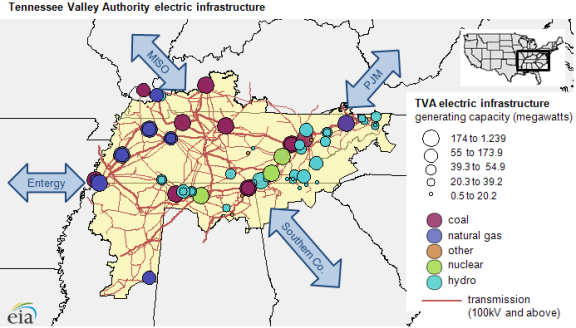
President’s proposed budget calls for strategic review of government’s role in TVA

Republished May 8 to correct text and graph.
The president's recently proposed budget for fiscal year 2014 included a strategic review of the federal government's role in the Tennessee Valley Authority (TVA). TVA is a federally owned corporation that owns and operates 56 power plants in the Tennessee Valley Region, which stretches across parts of six states (Alabama, Georgia, Kentucky, Mississippi, North Carolina, and Tennessee). TVA's plants are primarily hydroelectric, natural gas, nuclear, and coal-fired facilities with a combined net summer capacity of more than 35 gigawatts (GW), about 3% of the total U.S. electricity capacity.
According to the proposed 2014 budget, TVA's current capital investment plan includes more than $25 billion of expenditures over the next 10 years. TVA's current debt is roughly $25 billion, only $5 billion under the agency's $30 billion statutory cap on indebtedness. Given TVA's debt constraints and the effect on the federal deficit of its increasing capital expenditures, the budget proposal explained that reducing or eliminating the federal government's role in programs such as TVA could improve the country's fiscal conditions.
Congress established TVA in 1933 to address flood control, power supply, and economic development problems during the Great Depression. TVA expanded during World War II to produce the electricity for aluminum smelters in the region.
TVA currently owns and operates 303 generating units at its 56 plants. About one-third of the generators are hydroelectric, including the 1.6-GW Raccoon Mountain pumped storage facility in Tennessee. TVA's largest plants are the 3.3-GW Browns Ferry nuclear plant in Alabama, the 2.5-GW Cumberland coal plant in Tennessee, the 2.3-GW natural gas and coal Johnsonville plant in Tennessee (consisting of 30 generators), the 2.3-GW Sequoyah nuclear plant in Tennessee, and the 2.2-GW Paradise coal plant in Kentucky.
The utility's largest current project is the completion of the Watts Bar 2 nuclear unit in eastern Tennessee. Construction of this unit began in 1973, was suspended in 1985, and resumed in 2008. The project, which is behind schedule and over budget, is currently expected to be completed by the end of 2015.
| Type of electric generator | Number of generators | Net summer capacity (megawatts) | Capacity share of total (%) | ||
|---|---|---|---|---|---|
| Coal | 59 | 14,684 | 41.7 | ||
| Nuclear | 6 | 6,710 | 19.0 | ||
| Natural gas | 108 | 8,366 | 23.7 | ||
| Conventional hydro | 111 | 3,744 | 10.6 | ||
| Pumped storage | 5 | 1,702 | 4.8 | ||
| Other | 14 | 29 | 0.1 | ||
| Total | 303 | 35,235 | - | ||
Source: U.S. Energy Information Administration, Form EIA-860, Annual Electric Generator Report. | |||||
Rather than selling power directly to end users, TVA mostly sells wholesale power to other utilities, and they have a small number of industrial customers. TVA sells electricity to 155 utilities, providing power to more than 9 million people, 51 large industrial customers, and 6 federal installations.
TVA operates nearly 16,000 circuit miles of transmission lines and is connected directly to 14 other electric systems, including two major regional transmission organizations (PJM and MISO) as well as large territories operated by Southern Company and Entergy. The company is also strategically located in the central region of the eastern United States. These assets and their strategic location could enter into the valuation of TVA if a sale is pursued by the federal government.